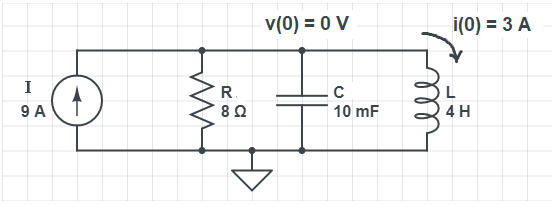
simulate this circuit – Schematic created using CircuitLab
I already did my own solution but I just want to check if I got everything right, especially in determining the initial conditions. Here is my own understanding:
So, for t<0, the current source and capacitor is an open circuit and the inductor will be a short circuit. Hence, all the current will flow to the short circuited inductor. $$ t<0: $$ $$ i(0) = 3A; $$ $$ v(0) = 30; $$ $$ \frac{di (0)}{dt} = \frac{30}{4} = 7.5 $$
Now, at t > 0: We could do source transformation with the 30V source and 10 ohm resistor, hence, everything will be in parallel. I combined the 6 A and the 3 A to get 9 A current source and combined the two resistances to get:
$$ t>0: $$ $$ i(0^+) = 9A; $$ $$ R = 10||40 = 8; $$ $$ resonant freq. = \frac{1}{√LC} = 5 = 7.5 $$ $$ α = \frac{1}{2RC} = 6.25 $$ $$ s_1 = -2.5, s_2 = -10 $$ Here we can see that we will have an overdamped response hence our solution would be of the form: $$ i(t) = I_f + A_1e^{-2.5t} + A_2e^{-10t} $$
To get A1: $$ i(0) = I_f + A_1 + A2 $$ $$ 3 = 9 + A_1 + A_2 $$ $$ -6 - A_2 = A_1 $$
To get A2: $$ \frac{di (0)}{dt} = \frac{30}{4} = 7.5 = -2.5A_1 + -10A_2 $$ $$ 7.5 = -2.5(-6-A_2) - 10A_2 $$ $$ A_2 = 1 $$ $$ A_1 = -7 $$
So my final equation would be: $$ i(t) = 9 -7e^{-2.5t} + e^{-10t} $$
Did I do everything right? I feel like my initial conditions analysis is wrong but when I checked using LTspice, im getting the current inductor to be almost 3A for t<0 and 9A for t>0. But when I check for voltage on the node of Vc, im getting 3mV which I don't understand.


